When a watch stops working it can be worrisome to people to not be able to tell the time or perhaps because the watch is a heirloom piece. First you must determine whether the watch movement inside that has failed is a mechanical or a quartz movement. There is sometimes no easy solution to fixing the failed movement. When you have a watch that has an older mechanical movement, parts can be very difficult or impossible to find and replacing the original movement with a quartz electronic movement is sometimes the only solution. If the inside of your watch has been damaged beyond repair, (by water damage or the watch has had a hard hit and it is not working) replacing the movement may be the only solution. Make sure that the problem is not just a dead watch battery or an automatic watch that has not been wound up and you could save yourself extra work.
In this article, you are going to learn how to identify quartz watch movements, along with selecting a replacement and then completely replacing it.
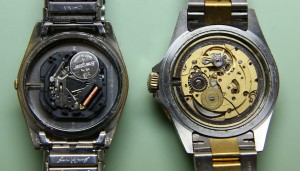 Quartz and Mechanical
Quartz and Mechanical
You can replace a mechanical movement with a quartz movement or change a quartz movement with an inexpensive generic or factory direct movement without problems. If the original watch movement has additional features including a day/date window or a chronograph with several mechanisms to show the seconds, year, moon phase, or stop watch, you will possibly lose some features if you do not find a direct matching replacement movement. Sometimes the movements are discontinued due to their age, but you still can get parts. This article will cover the situation where you cannot clean the old movement or order replacement parts like a coil or a circuit to make your favorite watch work again.
If you have a name brand watch like Longines, Seiko, Citizen, Pulsar, Lorus, Bulova, the generic direct matching movement could be obtained and the price might be actually lower than buying the original manufacturers movement or replacement parts and fixing the watch.
You will need some watch tools to help work on small mechanical and electrical parts of a watch:
- Movement Ring Assortment
- Watch Dial Adhesives
- Digital Caliper 100mm / 4″
- Hands Free Magnifier (OptiVisor)
- Eye Loupe Magnifier
- Watch Screwdriver Set
- Watch Battery Tester
- Brass Handle Pin Vise
- Non-Magnetic Tweezers
- Loctite Threadlocker
- Flush Side Cutter Pliers
- Needle files, Medium
- Watch Back Opener Knife
- Movement Holder
- Case Holder F/ L-G Case Wrench
- Watch Opener Case Wrench Waterproof or
- LG Case Back Opener Wrench
- Watch Hand-Remover
- Watch Hand Press
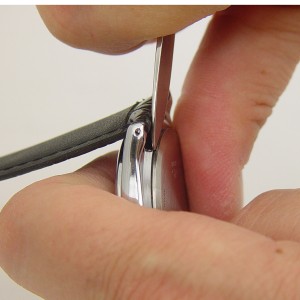 Open the Back
Open the Back
- A screw off watch back will have large notches around the edges of the back of the watch. Use a Case Opener wrench and Case Holder. Set the watch in the case holder and unscrew the back… Be careful – there is a gasket between the case and the back that needs to be replaced if you damage it.
- Another type of screw off watch case back has the notches cut out all around the case back. These are commonly seen on Swiss Army and Baume Mercier. For this type of case back removal you will need a case holder and watch case dies or a Watch Case Opener.
- Pressure fit watch back: The second type of watch case back is the pressure type. It is plain and smooth and we intend to leave it that way when we finish. Many watches with this type of back have a small dent or notch on the case back which is the place you will want to put your watch opener knife.
- 4 screws watch back: The third most popular watch case back has 4 screws holding the back on. It can be any kind of watch material, metal case and metal back, plastic or rubber case and metal back, plastic case and plastic back, and so on. You will need to determine if you need Phillips head screwdrivers or a straight edge. Choose the right screwdriver for the right screw. You don’t want to strip the head of the screw, and remember that there will be a gasket that you will have to deal with, so be careful.
See our Guide: How to Open a Watch Back
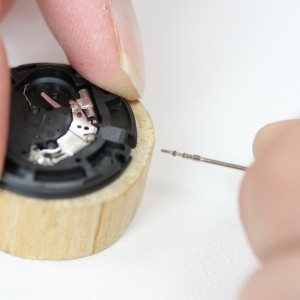 Remove the stem
Remove the stem
Locate the screw to be loosened if it is a threaded type or locate the dimple that you need to push to remove the stem. Lay watch face down on a Selvyt cloth or movement dial side down on a piece of pithwood. Turn the screw counter clockwise three to four turns (screw does not need to be removed from the movement) or push the dimple as you Pull to remove the stem.
See our Guides: Removing a Watch Stem – Screw Type or Removing a Watch Stem – Push Button Type Removal
Remove the movement ring, hands and then the dial. This is the first step to removing the old movement out of the watch case. Simply lift up on the movement ring where you see cut outs and be careful not to scratch any part of the movement with your tweezers or fingernail. Using a piece of pithwood place the movement on top of the pithwood then put a dial protector under the hands to protect the dial. Using a hand puller place over the hands and gently squeeze the hand puller and pull the hands off of the movement.
See our Guide: How to Remove Watch Hands
Identify the Movement you Need
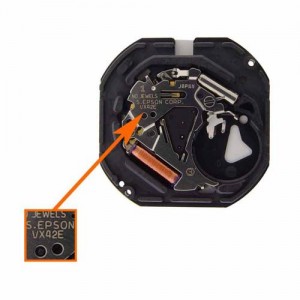 Quartz
Quartz
Now you need to look at your movement and see if there are any markings such as the manufacturer (Hattori, Miyota, ETA) and then look for a movement number. The Japanese brands are usually very easily identifiable as they are marked very clear on the movement (EX: VX42E, 6L12) If you are unable to find the movement number on the movement the Japanese will also usually make the movement number part of the case back and dial number. ETA movement numbers are usually on the very edge of the movement (EX: 955.1112, 210.011) or on the plastic movements under the cell in the battery well. These can be very hard to see and you will need to be very careful when ordering as being just one number off can change the diameter or features on a movement. (EX: 802.004, 802.104)
Mechanical
To find a quartz watch movement to fit a mechanical can take a bit more work. There are several things that you will have to look for and measure. First look under the balance wheel (The circular piece that looks like it has hair wound around the middle) to see if there are any symbols and numbers. (EX: AS in a schield, number 1977-2) Your watch movement supplier may sometimes have a listing for a good replacement that can save you some time. Next determine the shape of the movement, round rectangular, oval etc. Measure the diameter of a round, the width and the length on the ovals and rectangulars. Next measure the thickness of the movement.
Calendar and Date Features
When you are ready to work in a watch, you should consider if the watch has second hands or if the watch has a calendar feature. If it has a calendar window, it is located a 3 o’clock, 4 o’clock or 6 o’clock. You also have to be aware of how thick the dial is because sometimes the same movement has a long and short center shaft. The calendar wheel can be replaced, so if you do not find the same movement with the calendar at 6 o’clock, you’ll have to remove the old calendar wheel and replace it in the new movement.
Now look at the dial to see if it has a calendar for the date, if it does, you had to make sure that a calendar can be seen through the window. Does it have second hand? Where is the second hand located? Is it removed, for example, at 6 o’clock. If that is the case, our choices are very limited, some movements can have a matching calendar, but the second hand at 6 o’clock will have to go. You can’t have both.
See our guides: Watch Movement Identification and Watch Case Number Finding Guide
Replacing the Movement
Mechanical to Quartz Watch Movement
Replacing a mechanical watch movement with a quartz watch movement is always more complex, takes more time, and can cause several more difficulties than replacing a quartz movement. Most problems arise from the size difference of old mechanical (large) to new quartz (small) movements. If you pick a thinner quartz movement over the old mechanical there is a good chance that the hole where the stem goes outside the watch case may not align properly. (This will also cause the dial and hands not to fit properly) This is a very difficult or impossible situation that will require a professional watchmaker.
If you have a mechanical watch movement and you would like to replace it with a quartz watch movement – remove the old movement from the case, measure it, and let’s say its 17.5 milliliters round, by 4.75 mm thick. Ideally, you would match the same dimension to make the new movement fit right. If you cannot find a movement that is the same size, you can use a watch movement as close as possible to those dimensions and use other tools and parts to make the movement fit correctly.
You need to know how thick the dial is because the center shaft comes in different lengths and the watch hands will not fit on correctly in the end if you do not know the thickness. You also want to make sure when you place the movement in the dial that it would have enough space around the hour hand and the minute hand to be set.
When replacing mechanical watch movements, keep in mind:
- With mechanical watches you will always need to replace the watch hands because the old hands are heavy steel that will not work with quartz movements.
- You will need to take more effort in finding a close replacement size and then finding a good fitting movement ring to secure the quartz movement in place.
- You almost always have to use dial spots on mechanical movements because the dial feet will not match up (exception when you refinish the dial).
- You will likely need to replace the watch stem forcing you to also get a new watch crown. (A stem extender can help change the size of the new stem to fit the original old crown).
- If the dial is curved you will need to choose a new quartz movement with a very high center post because the movement will not fit flush to the dial causing the hands not to fit properly.
Quartz to Quartz Watch Movement
If you are replacing a quartz watch movement with another quartz movement you can usually find an exact replacement with no need for dial, hands, movement ring, stem, and crown.
Let’s say you have a good match, a movement smaller than the original, but with a calendar that fits, and a center shaft the goes fine with the dial so you know you will have a good match.
Attaching the Dial
Attaching the movement to the dial (the dial is the face of the watch) is very important for a long term fix and you have two choices for attaching the movement onto the dial depending on the design, your abilities, and what results you are looking for.
- Finding a direct replacement movement that will fit the dial feet (the dial feet are two small metal posts that are inserted into the movement)
- You can secure the movement to the dial with adhesive dial dots or use little glue dots. First the dial feet will need to be removed so you clip the original dial feet and make sure the surfaces is clean and smooth. Place the dial dots on the movement in a place that is safe, and press movement and dial together.
Using dial spots and glue is very convenient and quick when you cannot find a dial that matches the movement holes but the downfall is that with time and much wear, these shortcut fixes can come loose causing the movement to shift and cause further problems.
Dial Refinishing
If you need dial repair, you can send the dial into a dial refinishing company or through Esslinger Company. At the time of refinishing, you can instruct them to set the dial feet in a new position so that it will fit any movement. (so you would say that the feet need to fit an ETA 955-112 for example) You should make that information very clear and that is also one of the reasons that you should let a customer know, his/her watch will be done like the original manufacturer fitting perfectly and looking new. Now that you have the dial feet in the right place for the new movement and you have the new movement you are ready to insert into the watch case.
Setting the Watch Hands
After the dial is set, you can place the watch hands onto the post. Using a sharp tweezers, carefully place the hands over the posts in order (Hour, Minute, Second). Use the watch crown and set the correct time, you should be sure the hands are not touching each other (or the dial). Wait at least after 24 hours to make sure the hands move freely before you use the watch.
 Replacing the Watch Stem and Crown
Replacing the Watch Stem and Crown
When you purchase a new watch movement, it will usually include a watch stem, a temporary plastic crown, and the battery. To replace the old stem and crown, measure the old stem in millimeters, then cut the new stem down to the same size (using a side cutter and then tapering with a file) Thread the new stem onto the end of the watch crown. When you order a new movement, you might want to consider ordering two stems – then, if you cut the first one wrong, you will not have to order another one.
See our Guides: Removing a Watch Stem – Screw Type or Removing a Watch Stem – Push Button Type Removal
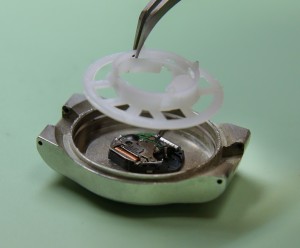 Movement Ring Replacement
Movement Ring Replacement
In the example , the movement is almost 2 milliliters thinner that the original that you are replacing, so you have to compensate for the movement thinness and it is also smaller in diameter. When doing that you have to look for a movement ring that will secure the movement in the watch case and prevent it from moving around loosely. A tight fit will not only help the watch work better, it will prevent possible damage that can occur so easily in wrist watches.
To help you have a good choice of movement rings for use with retrofitting many types of mechanical and quartz watches you can purchase the Movement Ring Assortment or you can make our own if you have some extra plastic movement rings. Hold the watch movement in place inside the watch case and compare each plastic movement ring to see which is nearest to the size, shape, and thickness of the new movement. The movement ring should hold the watch movement firmly in place with no play, but should not be pressing on sensitive electronic or mechanical parts of the watch movement.
Movement rings are made of a soft malleable plastic and can be formed and bent after getting to know the material. A good watchmaker can heat up the plastic and make some adjustments to make it fit quickly. Most movement rings need to be cut or trimmed on the outer edge to fit snuggly into the watch case and trim the top and sides (with sandpaper, jewelers files, dremmel machines)
 Closing the Watch Back
Closing the Watch Back
Depending on the type of watch back that you are closing, be sure that the back does not touch the movement ring before closing. Be sure to check the condition of the back gasket before you close the watch as this is a very easy time to replace it and keep your new movement free of dirt and moisture. Depending on the type of watch back again (screw back, pressure fit, 4 screws) you will pressure fit or use the same tools that you used to remove the watch back.
See our Guide: How to Close a Watch Back
Considerations
Sometimes when you change a movement from mechanical to quartz, not only you have to measure the diameter of the movement, the thickness, but also you have to consider the stem and crown, in some watches the case and the back are cut in a way that is not really an issue. But if the case has a tube or small hole where the stem goes; you have to make sure that the new movement will line up with that tube or hole. Also, if the case of the watch has a guard that protects the crown, you had to make sure that the new crown will fit between those guards.

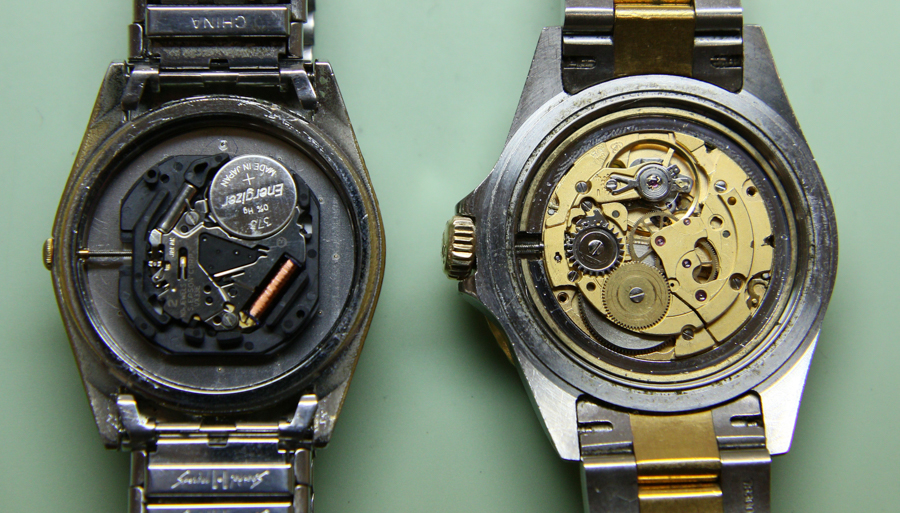
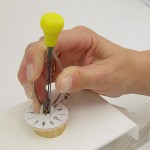
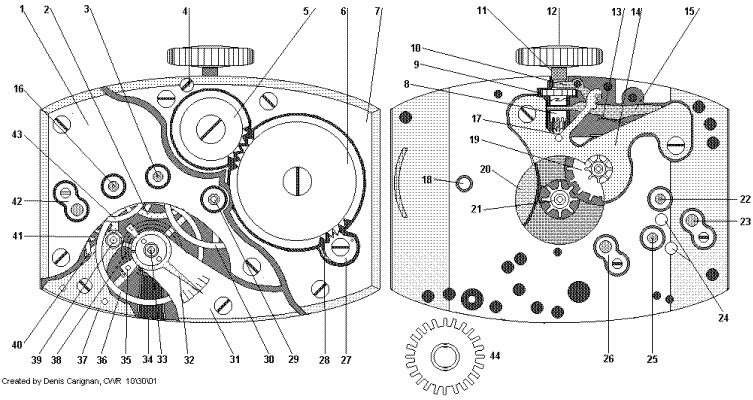
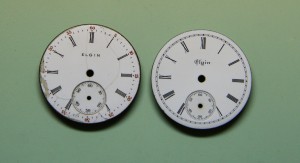

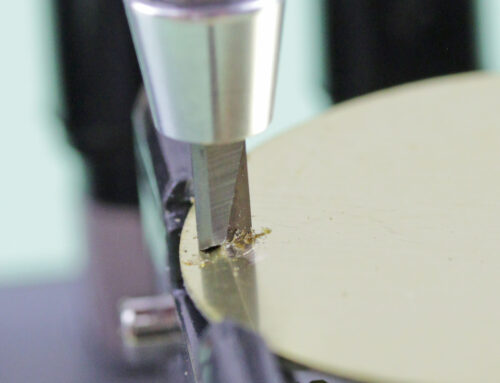
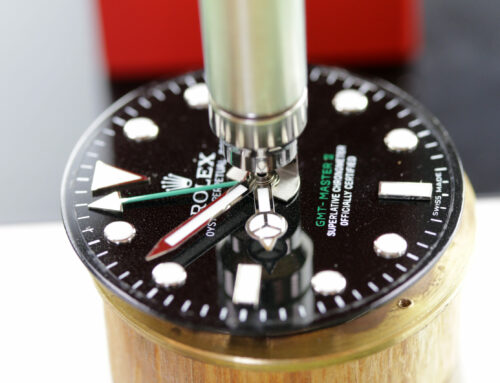

Re Changing Quartz watch battery:
Is there any truth in suggestions that the Pos & Neg pins need to be shorted to enable a quartz watch to function after changing a battery? I ask because mine watch is playing up.
This is absolutely true. specifically on brands like Casio and other electronic wrist watches; without a restart, the watch will not run.
Please specify Reset procedure
Thanks
Not sure whether your advice to short out the pins applies to all electronic watches, to rechargeable watches only, or to these Casio models only (not clear). I have a Remington analog watch that does not use a rechargeable battery. Would I need to short out the pins in replacing the battery on this watch? It is an SR916SW battery.
Hi, thanks for this! I have a Fossil JR-8561 case with a Ronda movement. The number looks like “515” maybe? There are several models on your site, any advice on which movement in particular?
Hello. I have purchased a second had omega speedmaster without a movement. Is it possible to find one that fits,
knowing it has a chronometer ? Thank you !
Hi
Thanks for the great article. May I check if movements are universal in size? I’m anniversary present watch died on me and I was wondering if I could replace the movement with a working one from another watch.
Would appreciate your kind advice on this. Rgds!
CT
Movements are not universal in size. Replacing the movement is possible but you will need to do some measuring and looking up the model and numbers. Check this article for more information: https://blog.esslinger.com/identifying-watch-movements/
Many thxs for the great help!
whether all auto winding mechanical watches need `clutch wheel` especially the ones with Day&Date?Please help me.
(and particularly Citizen` Eagle`series and SEIKO 6619A
I read your blog and I found this blog so interesting and informative. I like it. Thanks for sharing it.
I am trying to remove a fault quartz movement from a Rotary Swiss made dress watch steel case approximately 1978. I took the stem out all ok but this movement will spin inside the case but will not fall out of the case. I have take the 2 screws and retainers out but I cant work out what is still holding it in. No plastic ring holing the movement in as shown in many videos . I am looking to replace the movement , struggling to identify the movement inside the the watch at the moment
After reading this blog. It has very cleared to me the difference between quartz and mechanical movement watches. It’s really a very nice blog. I like it. Thanks for sharing it.
I have a British military watch by Hamilton. It has a fixed back, and is mechanical. It has been returned after cleaning and the movement is doing just that, moving when being wound. Sadly the clockmaker died after cleaning it and, I believe, forgetting the keeper. I have a crystal remover on the way from you but could you guide me to a keeper. The crystal measures 81.28mm. That is installed. Numbers on back are 19727/73, I think the age of is there. Thank you.
Please use the watch parts inquiry form for help finding parts for your watch. The parts department will research your request and get back to you in 2-3 business days.
https://www.esslinger.com/watch-parts-inquiry
Hy
It’s great to See that someone with understanding of watch will help with advice. Maybe you can give me advice..
I have bought, chronograph watch with China movement PE90 Sunon.. Watch case is great, but I want to change movement, since I do not like how its working…
Can you give me advice on wich movement shuld I buy? Quartz or mechanicle, or one of each, which model, main thing is that ist’s have Funktion like normal chronograph.. And that it is fairly simple to change movement..
Thanks Marco
Retro-fitting a new movement will largely depend on the size of the case, which functions it has, the date dial (if there is one), the height of the movement needed to clear the dial for the hands to fit. You may need new hands, stem, crown, dial spots, movement ring or more.
The best thing to do would be to use the watch parts inquiry form for help with your question. The parts department will do some research and get back to you in 2-3 business days with an answer.
https://www.esslinger.com/watch-parts-inquiry
Where can I buy a Quartz replacement movements for Chanel watch A.M. Swiss made or maybe fake. Watch: Chanel white 33 mm, 3.3 mm Ceramic white. Under the battery it appears to be letters “JUP” ???, very hard to read. On the back of the cover is written : Chanel, Paris , A.M. 82006
You can use the Watch Parts Inquiry Form for help finding the part you need. Fill it out with all the information you have for your watch and our parts department will research your watch with the given information and get back to you with a cost and availability of the parts.
https://www.esslinger.com/watch-parts-inquiry
I recently put together a 40mm from your Make your Own Watch kit. I think everything went perfectly except….the second hand is moving about 60 times faster than it should be. Its doing about one full revolution every second! What could be the cause of this?
Can i send my auto watch somewhere to have it replaced with quartz unit? It is a Seiko. Greg
really helpfull information regarding watch movement ,i really like sometimes if we can change watch movement of any watch.
I have a 70s Rolex Datejust. Manual winding. I love the watch as it was a gift but the daily winding routine I can do without. Not to mention, the watch is not particularly accurate. I was wondering if it’s possible to change the movement with something like an ETA 2824 or similar automatic movement. Replacing with a Rolex movement is probably cost prohibitive. I know I’ll probably get some flack but I’m a pragmatist, not a purist.
Please use our watch parts inquiry form found here: https://www.esslinger.com/watch-parts-inquiry/
Someone in the parts department will research your watch with the given information and get back to you as soon as they can with a price and availability of the parts you are looking for and answer any questions you may have.
I have personally always preferred an automatic watch, now that I have read this i will even transform one of my old watch into an automatic watch.Thank You Mate.
I am interested in buying the drive mechanism and other spare parts for my watch citizen eco drive blue angels c651. I can turn to you. Thanks for the help.
Please use our watch parts inquiry form found here: https://www.esslinger.com/watch-parts-inquiry/
Someone in the parts department will research your watch with the given information and get back to you as soon as they can with a price and availability of the parts you are looking for and answer any questions you may have.
I have a Mathis montabon classiqu mm04 with a Chinese automatic movements, can I replace with a quartz movement & can u supply the part
Please use our watch parts inquiry form found here: https://www.esslinger.com/watch-parts-inquiry/
Someone in the parts department will research your watch with the given information and get back to you as soon as they can with a price and availability of the parts you are looking for and answer any questions you may have.
I am looking for a substitute quartz movement to my 11A ladies seiko movement. Do you have something in stock please? I need also hands and stem. Thank you
Please use our watch parts inquiry form found here: https://www.esslinger.com/watch-parts-inquiry/
Someone in the parts department will research your watch with the given information and get back to you as soon as they can with a price and availability of the parts you are looking for and answer any questions you may have.
Dear staff,
What would be the replacement movement I could purchase for this Ronda movement serial number EOL R9 that is from a Victorinex Swiss Army Watch model 241563? I have been unable to find its equivalent online. The second hand on this movement is going counter clockwise.
Thank you for your attention.
Yours,
Kent Struck
Sent from my iPhone
Attachments area
Please use our watch parts inquiry form found here: https://www.esslinger.com/watch-parts-inquiry/
Someone in the parts department will research your watch with the given information and get back to you as soon as they can with a price and availability of the parts you are looking for and answer any questions you may have.
Hello! I am looking for a quality movement to replace my AS 536-121, can you help me? my original movement has a day and date.
Please use our watch parts inquiry form found here: https://www.esslinger.com/watch-parts-inquiry/
Someone in the parts department will research your watch with the given information and get back to you as soon as they can with a price and availability of the parts you are looking for and answer any questions you may have.
is there any way you could help me with a rolex datejust replacing the rotor
Please use our watch parts inquiry form found here: https://www.esslinger.com/watch-parts-inquiry/
Someone in the parts department will research your watch with the given information and get back to you as soon as they can with a price and availability of the parts you are looking for and answer any questions you may have.
My wife’s Longines L3.115.5 stops and starts sporadically. I sent it to Longines (Swatch) for a repair, but they said it would require them to send it to Switzerland and the repair could start at $300. In the written estimate they said that the movement is 280002, which I believe is an ETA movement that you sell for $65. I don’t necessarily feel comfortable changing the movement myself, but can you think of a reason that I couldn’t purchase the movement and bring it to a watch repair shop to have it installed? Failing that, how much would you estimate it would cost in tools to be able to do this myself?
You could probably do that and take it to a reputable watchmaker for the installation, but it might void any warranties you may have with Swatch or where you bought the watch from. We do sell the 280.002 ETA movement but it available in three different heights so you would have to take the movement out of the watch to measure the height of the movement to get the correct movement for your watch. Use this article to learn how to measure the height: https://blog.esslinger.com/how-to-measure-the-height-of-a-watch-movement/
If you are interested in doing this yourself, this article will help with the steps and some tools that you would need for this type of repair: https://blog.esslinger.com/how-to-replace-a-watch-movement/
i have an 80s 980.066 tag heuer Monnin quartz which I would like to change to a ETA movement and was wondering what you can recommend ? Kind wishes
Dave Southwood FRGS
Please use our watch parts inquiry form found here: https://www.esslinger.com/watch-parts-inquiry/
Someone in the parts department will research your watch with the given information and get back to you as soon as they can with a price and availability of the parts you are looking for and answer any questions you may have.
hi, can you tell me how remove the movement of a watch name vincero 3 hands with a movement serial # js20, not come out from the back and do not look open form the top. pls can you help me .